366 N. La Cienega Blvd. Los Angeles, CA 90048 | map |
Opened: May 5, 1947 with a film series by Paul Ballard's Hollywood Film Society. Early film events in the complex were frequently in spaces other than the main theatre and had to work around the main space's use as a legit venue. John Houseman's Pelican Productions had a one-year lease as the first tenant. The debut as a legit house was June 11, 1947 with a production of Thornton Wilder's "The Skin of Our Teeth" starring Jane Wyatt and Keenan Wynn. This was followed by the U.S. premiere of Bertolt Brecht's "Galileo," opening July 24, and then Jean-Paul Sartre's "No Exit" on August 23.
The complex, in the works since 1942, was a project of Frieda Berkoff, a member of a famous Russian dancing
family. She was known as Frieda Berkoff Gellis after her marriage to theatreman Sidney Gellis. The location is two blocks north of Beverly Blvd. The c.1958 photo of the Coronet by Danny Rouzer is from the Tim Lanza
Collection. It once appeared on the Largo at the Coronet website. In addition to the main theatre space, the building housed various offices, retail spaces and an upstairs dance studio / rehearsal hall. In the photo note Doug Weston's Troubadour in the south storefront, a tenant there from 1957 until 1961.
Various members of the Berkoff clan were also involved in several film houses including the La Tosca near USC, the Midway on Pico Blvd., the Esquire in the Fairfax district and the Cinema on Western Ave.
Phone: 310-855-0350 Online: www.largo-la.com | www.CoronetTheatre.la.com
Seating: 272 in the main space. The south storefront had also been used as a 60 seat cabaret space. Upstairs, the dance studio had been turned into a 99-150 seat space branded as "Upstairs at the Coronet" in 1999.
Architect: Lyle Nelson Barcume. His offices were nearby at 8457 Melrose Ave. Earlier theatre work included the 1936
Hughes / Franklin Theatre in Highland Park and the 1939
Monterey Theatre in Boyle Heights. It's a two-story wood frame building with 13,652 s.f. of space on two lots totaling 80' x 134'.
A drawing by the architect on display at the theatre. Photo: Cultural Heritage Commission - 2023
A main floor plan showing the entrance as "open foyer" south several of the storefronts. That's the main theatre space on the right. The undated plan located by Honor Dunn was drawn for a permit application at the time the south storefront was being converted by Flanny Productions into a performance space called "The Little Room at the Coronet Theater."
A plan of the south storefront as a 60 seat cabaret space.
A partial 2nd floor plan drawn for a 2004 permit application for installation of fixed seating in the "Upstairs at the Coronet" space in the dance studio. Thanks to Honor Dunn for locating this. With this layout the capacity was 96. The 2nd floor is accessed via an open set of stairs on the southwest corner of the courtyard, seen on this plan in the lower center. The theatre lobby is under the dance studio's seating area that we see here. The auditorium is off the plan to the right.
Main Stage Specs:
Proscenium width: 39'
Proscenium height: 13'
Curtain to footlights: 3' 6"
Curtain to backwall: 30'
Linesets: None -- what rigging there was used hemp
Grid height: 17' 9"
The data appeared in the 1949 edition of the ATPAM Theatre, Arena and Auditorium Guide.
Thanks to Bob Foreman for posting the publication on his Vintage
Theatre Catalogs blog. They noted that the rent at the time was $500 per
week.
Film at the Coronet: May 5, 1947 was the start of the first film series from Paul Ballard's Hollywood Film Society, just relocated from a residence in Hollywood. Thanks to Ranjit Sandhu for his research. See the PDF of his "Paul Ballard at the Coronet" scrapbook. His coverage of film at the Coronet is intertwined with his extensively researched article on Buster Keaton's "The General." See his Coronet Theatre chapter.
The theatre had a long
history as a home for experimental film. Kenneth Anger
showed some of his early works there. In 1950 Raymond Rohauer took over
the operation with his "Society of Cinema Arts" and "Coronet Louvre"
programming with daily screenings of classics, experimental and foreign
films. Screenings could be in the main theatre when it wasn't in use for a legit show. In the first couple years of Rohauer's tenure those legit bookings were sparse, typically three or four runs a year. From 1953 to 1960 there was evidently only one legit show, in 1958.
Programs at this "one man cinematheque" sometimes changed daily, some films ran longer. In 2011 Manohla Dargis, in her November 6 New York Times article "Laboring in the Shadow of
Hollywood," called the Coronet Theatre's years under Rohauer "legendary." See Ranjit's chapters on Raymond Rohauer and Back to Rohauer.
The Coronet is discussed in "Alternative Projections: Experimental Film in Los Angeles, 1945-1980" (John Libbey Publishing, 2015). It's an anthology edited by David E. James and
Adam Hyman with much of the content generated for the Getty Research
Institute's "Pacific Standard Time" initiative. It's available from Indiana University Press or Amazon. There's an article about it on the Los Angeles Review of Books website. See the Alternative Projections site for, among other items, a short biography of Rohauer.
Tim Lanza discusses the Rohauer era at the Coronet at length in "Raymond
Rohauer and the Society of Cinema Arts (1948-1962): Giving the Devil
His Due," chapter 17 of the book. Thanks to Ranjit Sandhu for locating it. Some excerpts from Lanza's discussion:
"... Rohauer's involvement in film exhibition and distribution in Los Angeles beginning in the late 1940s, in particular his involvement in the access to and exhibition of experimental film, is not well known. But it is undeniable that the activities of his Society of Cinema Arts, particularly through the exhibition of film at the Coronet Theatre (where [Stan] Brakhage would briefly work and later refer to as the best public theatre for the regular presentation of film in the country), had a profound impact on a generation of filmmakers and scholars living in the Los Angeles area during the 1950s....
"In 1950, the twenty-five year old Rohauer began presenting occasional programs at the Coronet Theatre at 366 North La Cienega, which became for the next twelve years the Society of Cinema Arts's primary venue. The earliest announcement found for one of these programs was for a six day series co-sponsored by Kenneth Anger and Curtis Harrington's Creative Film Associates, entitled 'Illuminations." The program was billed as the West Coast premiere of ten new avant-guarde films, though the veracity of that claim is in doubt. The films screened nightly from 20-26 January 1950, and included Anger's 'Escape Episode' (1944), 'Fireworks' (1947), and 'Puce Moment' (1949; Harrington's 'Fragment of Seeking (1946) and 'Picnic' (1948); James Broughton's 'Mother's Day' (1948); and Sidney Peterson's 'The Lead Shoes' (1949).
"On 8 August 1950, the Society premiered what it called the 1st Annual International Film Festival, which offered over the course of the month nightly screenings organized into seven separate programs. While featuring important silent and sound films, such as Paul Leni's silent horror film 'Waxworks' (1924) and Sergei Eisenstein's 'Ten Days That Shook The World' (1928) and 'Thunder Over Mexico' (1932/34), half of the festival's programming days were devoted to experimental film. It included a four-day program of selections from the collection of the San Francisco Museum of Art such as Frank Stauffacher's 'Zigzag' (1948) and 'Sausalito' (1948). It also included a five-day program of American and French works, such as Gregory Markopoulos's 'Xmas-USA' (1949) and three films by Man Ray.
"There was also a five-day program entitled 'The Abstract Film As Entertainment," which included eight films by Norman McLaren. A preview of upcoming Society screenings at the Coronet, printed on the back of the festival announcement, lists a variety of American and European silent and sound studio pictures, short films about artists, and dance films. When taken with the experimental films from the festival, these other films provide a clear view of the programming direction that the society would take...
"What is most impressive is the sheer volume of work presented during each calendar period, and Rohauer's ability to sustain consistent screenings every day of the year for more than a decade. He ran multiple films each evening, as well as matinees on the weekends... Sometime between 1950 and the beginning of 1951, daily programming began in earnest at the Coronet, which Rohauer specifically stated was not a theatre; he instead dubbed it 'The Coronet-Louvre Museum of Arts and Sciences,' bringing 'genuine art and experimental film to the discriminating film devotee.'... The Coronet became one of the most important film venues in L.A...."
Lanza goes on to cite tributes from a number of filmmakers and scholars who attest to the amazing variety of Rohauer's programming and the influence it had on their film education. For more about Raymond Rohauer's dealings with Buster Keaton see Ranjit Sandhu's article on "
The General" and his 200+ page "
Coronet in the Newspapers" clipping scrapbook.
Several Coronet film calendar covers included by Tim Lanza in his "Alternate Projections" chapter. On the left it's one from April 12 to May 13, 1951. At center it's the schedule for February 1 through March 7, 1952. On the right it's the cover for the program running from June 20 until August 7, 1959.
In October 1957 Rohauer was arrested during a screening of John E. Schmitz's "Voices" and Kenneth Anger's gay-themed "Fireworks." He was convicted on obscenity charges but the verdict was overturned on appeal. After nearly a decade at the Coronet, Rohauer moved on to the Riviera/Capri in 1959. It was a
twin venue that's now a single-screen operation called the New Beverly.
Dance at the Coronet: For over four decades the second floor studio was used for classes taught by Frieda Berkoff Gellis, Roland Dupree, David Winters and others. Among those using the studio were Mitzi Gaynor, Barry Ashton, Nancy Sinatra, Betty Grable, Lucille Ball, Ann-Margret and Anthony Quinn. In 1999 the space was turned into another legit performance area.
Legit at the Coronet: The theatre has been mostly famous as a live theatre venue, hosting
over 300 productions. The operator of the theatre space for the first year was John Houseman's Pelican productions. The first production was the west coast premiere of Thornton Wilder's "The Skin of Our Teeth" on June 11, 1947. Following the closing of the first production, stage star Blanche Yurka did a one night appearance on June 29.
The U.S. premiere of "Galileo," Bertolt
Brecht's 1938 play with music, was evidently supposed to be July 24 but the opening took place July 30. The production was directed by Joseph Losey and starred Charles Laughton. Thanks to Honor Robie for sharing this image of the program cover. Opening night attendees included Charlie and Oona Chaplin, Ingrid Bergman and Frank Lloyd Wright.
The headline for Edwin Schallert's review in the Times on July 31 called it an "arresting footlight event." While the program says it was the world premiere, there had been a production in Switzerland in 1943. This was, however, the premiere of a new English adaptation assembled by Laughton, who spoke no German, and Brecht, who had minimal command of English. "Galileo" was followed by a production of Jean-Paul Sartre's "No Exit," opening August 21, 1947.
A 1947 ad for "Dark of the Moon." Thanks to Ken McIntyre for locating this for a thread about the theatre on the
Photos of Los Angeles Facebook page. The show had opened October 3. Other 1947 productions were Lorca's "The House of Bernarda Alba," opening on November 13, and a "Holiday Special" show on December 25.
Early 1948 productions included "Dipper Over Gimbels" (opening February 4), "The Vigil" (March 10) and a moveover of "The Glass Menagerie" from the Las Palmas (March 30).
In April 1948 the theatre opened a production of "The Stone Jungle" directed by Lloyd Bridges, starring Shepperd Strudwick and featuring a very young Russ Tamblyn. Russ talks about it in a "
Here's the Thing" podcast. Thanks to Ken McIntyre for locating the ad.
Later 1948 productions included "The Survivors" (opening May 22), "The Adding Machine" (June 8), "Cupid Thumbs His Nose" (July 21), "The Glass Pool" (August 18), "Lucy" (September 15), "Eurydice" (October 15), "Bagels and Bows" (November 24) and "Now Is the Winter" (December 25).
Early 1949 productions were "Caligula" (opening April 4), four one acts (May 3), "Anna Lucasta" (June 10) and "Blood In the Streets" (July 14).
A 1949 ad for a production of Jean Paul Sartre's "The Respectful Prostitute." Thanks to Ken McIntyre for locating it for a post on the
Photos of Los Angeles Facebook page. The show opened September 20.
Later productions in 1949 were "Behold the Day" (opening October 12) and "Galatea" (December 25). The shows in 1950 were "The Uninvited Guest" (April 20), "The Three Musketeers" and "The Burning Bush" (September 22).
In 1951 noted Broadway actress Irish March directed a production of Claude Andre Puget's "The Happy Days" starring Kay Christian, Dana Earle and Micaela Mitchell. This ad, and a review by Katherine Von Blon, appeared in the July 21, 1951 issue of the L.A. Times. The show opened July 18 and closed July 25.
The only other legit production in 1951 was "Breakwater" (running July 27 and 28). Shows in 1952 were "Heir to the Flesh" (opening January 7) and, in the "Coronet Studio Theatre," "Burning Bright" (running October 2 to October 19). There were no legit shows at all from 1953 through 1960 except "The Crooked Tree" in April 1958. This data comes from a list kept by the late Petrie Robie, a daughter of Frieda Berkoff Gellis. Thanks to Petrie's daughter Honor Robie Dunn for making it available.
The theatre became a legit venue again in March 1961. In November 1961 the world premiere of Edna St. Vincent Millay's "Conversations at Midnight" was at the Coronet.
A view from a production of "Hamlet" in January 1962. It's a photo from the collection of the late Petrie Robie.
"Best of Billy Barnes" in August 1963. Thanks to Bruce Kimmel for sharing the image of the program that's in his collection. He comments:
"Most of Billy's shows were at the
Las Palmas, but in 1962 they moved to the Coronet - first with 'Billy Barnes LA' in October of 1962, which was my first BB show, then with 'Best of Billy Barnes' in 1963, which I also saw. Billy and I ultimately became good friends and I issued 'Billy Barnes LA' on CD just before he passed away. We had lunch two weeks prior to that sad day."
The theatre was home to
Ray Bradbury's Pandemonium Theatre Co. beginning in 1964.
"The World of Ray Bradbury" at the Coronet in 1964. Thanks to Ken McIntyre for locating the ad. Bruce Kimmel notes: "Opened on October 14, 1964 and the 'limited engagement' lasted all the way to Feb 14th, 1965 and was followed by another Bradbury play, 'The Wonderful Ice Cream Suit.'"
In December 1968 the Coronet was the venue for the west coast premiere of John Herbert's "Fortune and Men's Eyes." The regular run opened in January 1969 and ran until July. Thanks to Noirish Los Angeles contributor Ethereal Reality for finding the program. See his
Noirish Los Angeles post #50030 for several inside pages.
A July 1969 ad located by Ken McIntyre.
The porno era:
The theatre had become a gay porno film operation by April 1971. Evidently with a title the Times didn't want to print in this case.
A May 1971 ad located by Ken McIntyre.
A 1972 ad for "Boys in the Round" that was located by Ken McIntyre.
"The New Coronet Action Theatre" represented a quest for a different clientele with a burlesque operation. It's a 1973 ad, another find by Ken McIntyre. It's unknown who the theatre was leased to at the time.
Another 1973 ad located by Ken McIntyre.
A return to legit: The Coronet became a legit operation again in 1975. Frieda Berkoff Gellis continued to own and manage the the building until 1976 when, due to illness, she turned it over to her daughter Petrie Gellis Robie. Frieda died in 1991.
From 1981 to 1988 the building was home to L.A. Public Theatre, directed by Peg Yorkin. From 1990 to 1994 it was programmed by Serendipity Theatre Co., a children's theatre operation. In 1996 Robie sold the building for $1.7 million to Deborah Del Prete and Gigi Pritzker of Dee Gee Entertainment. They continued to book legit shows and added the 99-150 seat space upstairs in the former dance studio.
Operating it until 2007, some of the productions that the team booked included A.R. Gurney's "Sylvia" (1997), "I Love You, You’re Perfect, Now Change" (1998), "When Pigs Fly" (1999), "The Vagina Monologues" (2000), "Puppetry of the Penis" (2004), "Snoopy The Musical" (2002) and Jonathan Larsen’s "Tick…Tick…Boom" (2006).
A new owner and tenant: The building was sold in 2007 to its current owner Hersel Saeidy, doing business as Coronet Theatre LLC. He had intended to demolish the complex for an Urban Outfitters store until Mark Flanagan's Largo operation offered him a long term lease.
Status:
Since 2008 the theatre has been the home of Largo at the Coronet,
featuring comedy and music performances. The Largo had earlier been in a smaller facility at 432 N. Fairfax. See the May 18, 2008 L.A. Times story "
Largo gets new lease on life at the old Coronet."
In December 2023 the building was designated a City of Los Angeles Historic-Cultural Monument. It was a project energetically pursued by Honor Robie Dunn and her daughter Chloe Dunn. Brava! Visit the
Preserve Coronet website and don't miss the site's
history page. See a
PDF
from the Los Angeles Cultural Heritage Commission with a gallery of
photos from an August 2023 staff inspection as well the theatre's
nomination application.
The courtyard:
Looking in from La Cienega. The theatre lobby is through the doors to the left. It's a photo by Lincoln Andrew DeFur for Largo that appears on the site
Time Out.
A view south with La Cienega out through the gates on the right. The theatre runs parallel to that east wall of the courtyard seen on the left. That's the dressing room wing straight ahead. It's a photo taken during a visit by the Cultural Heritage Commission. See a
PDF
from the CHC with a gallery of
their August 2023 inspection photos as well the theatre's
nomination application.
Looking toward La Cienega. The black door on the left goes into the dressing room wing. Thanks to Honor Dunn for including this shot in her application for Historic-Cultural Monument status for the building.
Out toward La Cienega. Photo: Cultural Heritage Commission - August 2023
The east wall of the courtyard with the boxoffice at the left. The double doors are an exit from the house right side of the auditorium. The house left side exits to the alley. Photo: CHC - August 2023
On the left we're looking north into the theatre's lobby. The dance studio is above the lobby. The windows on the second floor above the "Largo" signage are in a hall alongside the
auditorium that connects the dance studio to the second floor of the dressing room wing. Photo: CHC - August 2023
Lights up for Christmas 2025. Thanks to John Bernstein for sharing this photo in a
Facebook post.
The lobby:
Looking into the lobby from the courtyard. Restrooms are on the right
with an entrance to the auditorium off to the right down at the far end. Thanks to Honor Dunn for sharing the photo.
A look in during the August 2023 visit of the Cultural Heritage Commission.
A view back toward the courtyard. The auditorium entrance is just out of the frame to the left. Photo: CHC - August 2023
The auditorium entrance. Photo: CHC - August 2023
The auditorium:
A look down from the booth. It's a photo credited to Largo that appears on a
Time Out page about the venue.
A 2016 view to the back of the house from Largo on
Twitter.
A look to the stage taken during the Cultural Heritage Commission's August 2023 visit. The courtyard is through the open door on the right.
A view to house left. Photo: Cultural Heritage Commission - August 2023
A look to house right. Photo: CHC - August 2023
The rear of the auditorium. Photo: CHC - August 2023
Backstage. Photo: CHC - August 2023
A dressing room. Photo: CHC - August 2023
Another dressing room. Photo: CHC - August 2023
The north bar, aka the Roger Room:
The bar north of the entrance passage off La Cienega. Thanks to Honor Dunn for including the photo in her application
for Historic-Cultural Monument status for the building. See a
PDF from the Los Angeles Cultural Heritage Commission that includes the application.
A closer look at the mural in the seating area at the end of the bar. Photo: CHC - August 2023
A look in the other direction. Photo: Cultural Heritage Commission - August 2023
A seating detail. Photo: courtesy of Honor Dunn
Seating at the north end of the space. Photo: courtesy of Honor Dunn
The south storefront bar, aka The Little Room, The Little Theatre:
A busy night at the bar space in the former storefront south of the entrance off La Cienega. Thanks to Honor Dunn for sharing the photo.
A look down the bar toward the entrance. Photo: Cultural Heritage Commission - August 2023
Looking toward La Cienega. Photo: CHC - August 2023
A view back to the bar. Photo: CHC - August 2023
Upstairs:
On the landing looking into the second floor of the dressing room wing that runs along the south side of the courtyard. Photo: Cultural Heritage Commission - August 2023
The second floor dressing rooms, used as a storage area. The space continues beyond the black drapes. Photo: CHC - August 2023
Looking back toward the entrance door on the stairs. The windows look north into the courtyard. Photo: CHC - August 2023
The back hall connecting the dressing room wing to the second floor dance studio. The courtyard is to the left, the upper part of the auditorium to the right. Photo: CHC - August 2023
Farther down the hall. Photo: CHC - August 2023
A view from the bridge. It's from a page about the venue on the site
See Tickets.
Another look down from the bridge. Photo: CHC - August 2023
Looking south on the bridge with the dressing room wing off to the left. Photo: CHC - August 2023
On the bridge looking north with the courtyard off to the right, La Cienega off to the left. The dance studio is through the doors straight ahead. Some of the building's office areas are through the open door on the left. Photo: Cultural Heritage Commission - August 2023
A peek into the dance studio. Photo: CHC - August 2023
The dance studio in the northeast corner of the second floor. Photo: CHC - August 2023
A door to one of the office areas. La Cienega is off to the left. Photo: CHC - August 2023
The office space seen through the door in the previous shot. Photo: CHC - August 2023
Another view from the bridge. Here we're looking toward La Cienega. More office spaces are behind the door on the left. The door to the offices facing the street on the north end of the building as well as the dance studio entrance are behind us a bit and off to the right. Photo: CHC - August 2023
More street views:
A 1960s photo. Note the "Coronet Studio" signage for Frieda Gellis, née Berkoff, and Roland Dupree. Thanks to Honor Robie Dunn, granddaughter of Frieda, for sharing this shot from the Robie family collection. It's included in her application
for Historic-Cultural Monument status for the building. See a
PDF
from the Los Angeles Cultural Heritage Commission that includes the application.
The Coronet in 2010. Photo: Google
Maps
A view north along the facade that appears on the site
City Seeker.
The building in 2021. Photo: Google Maps
Just inside the entrance gate. Photo: Cultural Heritage Commission - August 2023
The back of the building. The stage loading doors are at the left. The covered exits half way down are from the house left side of the auditorium. The staircase is an exit from the second floor dance studio. Thanks to Honor Dunn for sharing the image.
The Coronet in the Movies:

Anouk Aimée drives past the Coronet in
Jacques Demy's "Model Shop" (Columbia Pictures, 1969). She's being followed by
Gary Lockwood in his MG as she goes north on La Cienega. The
film also features Alexandra Hay, Carol Cole, Tom Holland, Severn
Darden and Neil Elliot. The cinematography was by Michel Hugo. See the
Historic L.A. Theatres in Movies post for another Coronet shot as well as views of the Tiffany and Melrose theatres.

The Coronet gets a preview of a new film at the end of William Tannen's "Nobody
Knows Anything" (Echelon Studios, 2003). It's a not-funny comedy with Ulanna Ubach
playing a young lady who thinks making a movie will be easy. The film features a
terrific supporting cast including Margaret Cho, Stephen Colbert, Mike
Connors, Paul Dooley, Janeane Garofalo, Ed Lauter, Michael Lerner,
Virginia Madsen, Mike Myers, Mary Kay Place, Fred Willard and Ben
Stiller. The cinematography was by Irek Hartowicz. See the
Historic L.A. Theatres in Movies post for two more shots from the scene at the Coronet.
The Coronet in music videos:
The exterior of the theatre is seen in several shots of "
Our Lips Are Sealed"
from the Go-Gos' 1981 album "Beauty and the Beat." It's on YouTube.
Thanks to Jonathan Raines for spotting the theatre. It's unknown where
the stage views were shot -- perhaps also at the Coronet.
More information: Petrie Gellis Robie, the daughter of Frieda Berkoff Gellis, started a Friends of the Old Coronet Theatre Building private Facebook group. Petrie died in January 2021 but the group continues, now moderated by Petrie's daughter Honor Robie Dunn. Thanks to Honor for all her research on the building and the various productions it housed.
Visit the Preserve Coronet website and don't miss the site's history page. See a PDF
from the Los Angeles Cultural Heritage Commission with a gallery of
photos from an August 2023 staff inspection as well as the theatre's
nomination application. It became a City Historic-Cultural Monument in December 2023.
The Coronet is discussed as a home for experimental film beginning on page 218 in David James' 2005 book "Most Typical Avant Garde: History and Geography
of Minor Cinemas in Los Angeles." The author is a professor in
the school of Cinema-Television at USC. The book is available from the University of California Press or Amazon. A preview is available on Google Books.
The Coronet is one of eight theatres discussed in Jon Ponder's 2018 Wehoville article "Vanished Venues: The Forgotten History of West Hollywood's Old Theatre District." Also see the separate chapter about the Coronet.
See the Wikipedia page on the history of the Coronet. Yelp has a page on Largo at the Coronet that includes some photos.
See our page on this site about various other 16mm Revival Houses that had opened between 1940 and 1975.
| back to top | Westside theatres | Hollywood | Westwood and Brentwood | Along the Coast | Westside theatres: alphabetical list | Westside theatres: by street address | Downtown theatres | [more] Los Angeles movie palaces | Los Angeles theatres - the main alphabetical list | theatre history resources | film and theatre tech resources | contact info | welcome and site navigation guide |















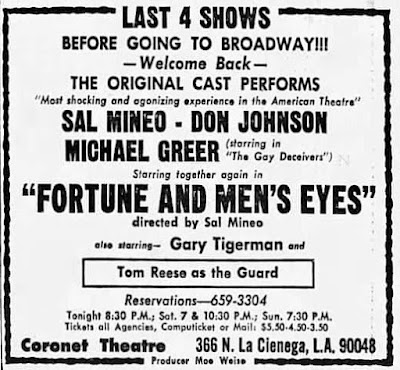








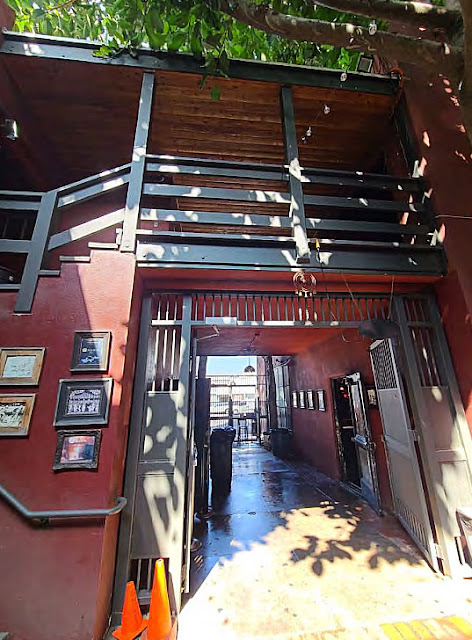

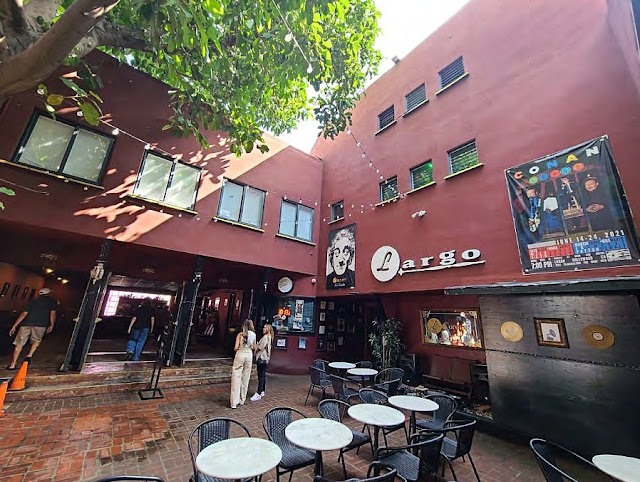







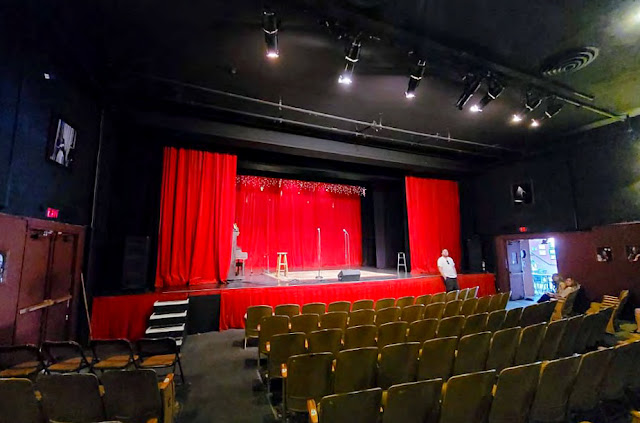
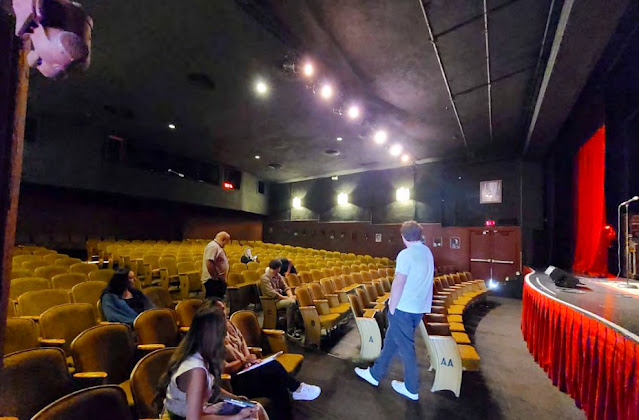
































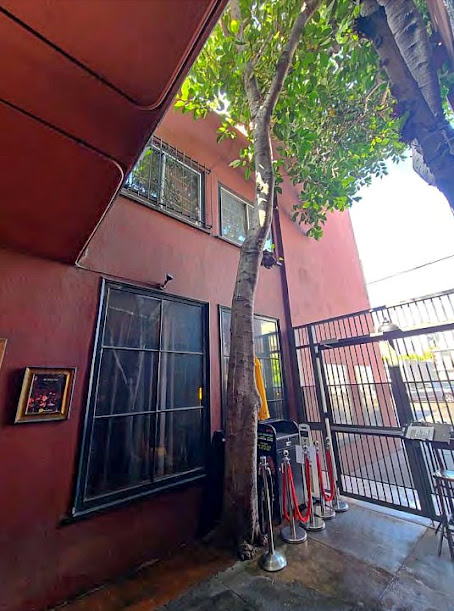




Cross-posted on Cinema Treasures:
ReplyDeleteWhen Largo was on Fairfax it was 432, not 423. https://www.loopnet.com/property/432-36-N-Fairfax-Los-Angeles-CA-90036/06037-5527030021/ https://www.facebook.com/Largo-on-Fairfax-152100758208445/ https://www.yelp.com/biz/largo-los-angeles
423 was a Woolworth’s and then Cohen’s deli, which was eventually taken over by Canter’s as their second dining room.
Thanks, Sandi! Much appreciated. I've fixed it up.
DeleteA minor footnote - for maybe two years in the early 1980's the old Sherwood Oaks Experimental College (run by the late Gary Shusett) was based in the small upstairs offices at the Coronet Theatre. One room in the very back that held maybe 20 people was used for classes. Previously the always struggling school had been at 6353 Hollywood Boulevard (upstairs) and then at the old Hollywood Center Theatre on Las Palmas just below Sunset. Tom Rombouts, attended classes and events put on by the school for a few years starting in mid 1980.
ReplyDeleteThanks!
Delete